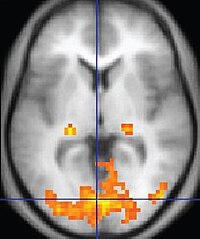
In‐scan and scan–rescan assessment of LV in‐ and outflow volumes by 4D flow MRI versus 2D planimetry
Sign Up to like & getrecommendations! Published in 2018 at "Journal of Magnetic Resonance Imaging"
DOI: 10.1002/jmri.25792
Abstract: To evaluate the in‐scan and scan–rescan consistency of left ventricular (LV) in‐ and outflow assessment from 1) 2D planimetry; 2) 4D flow magnetic resonance imaging (MRI) with retrospective valve tracking, and 3) 4D flow MRI… read more here.
Keywords: flow mri; planimetry; rescan assessment; scan scan ... See more keywords

Uteroplacental and Fetal 4D Flow MRI in the Pregnant Rhesus Macaque
Sign Up to like & getrecommendations! Published in 2019 at "Journal of Magnetic Resonance Imaging"
DOI: 10.1002/jmri.26206
Abstract: Pregnancy complications are often associated with poor uteroplacental vascular adaptation and standard diagnostics are unable to reliably quantify flow in all uteroplacental vessels and have poor sensitivity early in gestation. read more here.
Keywords: fetal flow; mri pregnant; flow mri; uteroplacental fetal ... See more keywords

Close look at the Potts shunt flow hemodynamics in a patient with severe pulmonary hypertension: 4D‐flow MRI evaluation
Sign Up to like & getrecommendations! Published in 2019 at "Journal of Magnetic Resonance Imaging"
DOI: 10.1002/jmri.26554
Abstract: Surgical or interventional creation of an anastomosis between the left pulmonary artery and the descending aorta, commonly known as the Potts shunt, was originally described as a method of supplementing pulmonary blood flow in infants… read more here.
Keywords: flow mri; flow; potts shunt; hemodynamics ... See more keywords

Assessment of Cerebral Blood Flow Pulsatility and Cerebral Arterial Compliance With 4D Flow MRI
Sign Up to like & getrecommendations! Published in 2019 at "Journal of Magnetic Resonance Imaging"
DOI: 10.1002/jmri.26978
Abstract: Four‐dimensional flow magnetic resonance imaging (4D flow MRI) enables efficient investigation of cerebral blood flow pulsatility in the cerebral arteries. This is important for exploring hemodynamic mechanisms behind vascular diseases associated with arterial pulsations. read more here.
Keywords: blood flow; flow mri; pulsatility cerebral; cerebral blood ... See more keywords

Dual‐Venc acquisition for 4D flow MRI in aortic stenosis with spiral readouts
Sign Up to like & getrecommendations! Published in 2019 at "Journal of Magnetic Resonance Imaging"
DOI: 10.1002/jmri.27004
Abstract: Single Venc 4D flow MRI with Cartesian readout is hampered by poor velocity resolution and noise when imaging during diastole. Dual Venc acquisitions typically require the acquisition of two distinct datasets, which leads to longer… read more here.
Keywords: dual venc; flow mri; venc acquisition;

Reproducibility of Aorta Segmentation on 4D Flow MRI in Healthy Volunteers
Sign Up to like & getrecommendations! Published in 2020 at "Journal of Magnetic Resonance Imaging"
DOI: 10.1002/jmri.27431
Abstract: Hemodynamic aorta parameters can be derived from 4D flow MRI, but this requires lumen segmentation. In both commercially available and research 4D flow MRI software tools, lumen segmentation is mostly (semi‐)automatically performed and subsequently manually… read more here.
Keywords: flow mri; reproducibility aorta; lumen segmentation; mri ... See more keywords

Whole‐Heart 4D Flow MRI for Evaluation of Normal and Regurgitant Valvular Flow: A Quantitative Comparison Between Pseudo‐Spiral Sampling and EPI Readout
Sign Up to like & getrecommendations! Published in 2021 at "Journal of Magnetic Resonance Imaging"
DOI: 10.1002/jmri.27905
Abstract: Pseudo‐spiral Cartesian sampling with compressed sensing reconstruction has facilitated highly accelerated 4D flow magnetic resonance imaging (MRI) in various cardiovascular structures. However, unlike echo planar imaging (EPI)‐accelerated 4D flow MRI, it has not been validated… read more here.
Keywords: flow; epi; flow mri; pseudo spiral ... See more keywords

Intracranial Blood Flow Quantification by Accelerated Dual‐venc 4D Flow MRI: Comparison With Transcranial Doppler Ultrasound
Sign Up to like & getrecommendations! Published in 2022 at "Journal of Magnetic Resonance Imaging"
DOI: 10.1002/jmri.28115
Abstract: Dual‐venc 4D flow MRI, recently introduced for the assessment of intracranial hemodynamics, may provide a promising complementary approach to well‐established tools such as transcranial Doppler ultrasound (TCD) and overcome some of their disadvantages. However, data… read more here.
Keywords: flow mri; dual venc; venc flow; flow ... See more keywords

Editorial for “Evaluation of Pulmonary Hypertension Using 4D Flow MRI”
Sign Up to like & getrecommendations! Published in 2022 at "Journal of Magnetic Resonance Imaging"
DOI: 10.1002/jmri.28235
Abstract: Magnetic resonance imaging (MRI) has been widely used for the assessment of the function and structure of the cardiovascular system. Compared with other noninvasive imaging techniques, MRI can provide both quantitative and qualitative information, resulting… read more here.
Keywords: time; pulmonary hypertension; flow; flow mri ... See more keywords

Comprehensive Neonatal Cardiac, Feed and Wrap, Non‐contrast, Non‐sedated, Free‐breathing Compressed Sensing 4D Flow MRI Assessment
Sign Up to like & getrecommendations! Published in 2022 at "Journal of Magnetic Resonance Imaging"
DOI: 10.1002/jmri.28325
Abstract: Cardiac MRI is an important imaging tool in congenital cardiac disease, but its use has been limited in the neonatal population as general anesthesia has been needed for breath‐holding. Technological advances in four‐dimensional (4D) flow… read more here.
Keywords: free breathing; non; comprehensive neonatal; flow mri ... See more keywords

Hemodynamic Evaluation of Type B Aortic Dissection Using Compressed Sensing Accelerated 4D Flow MRI
Sign Up to like & getrecommendations! Published in 2022 at "Journal of Magnetic Resonance Imaging"
DOI: 10.1002/jmri.28432
Abstract: 4D Flow MRI is a quantitative imaging technique to evaluate blood flow patterns; however, it is unclear how compressed sensing (CS) acceleration would impact aortic hemodynamic quantification in type B aortic dissection (TBAD). read more here.
Keywords: flow mri; aortic dissection; compressed sensing; type aortic ... See more keywords